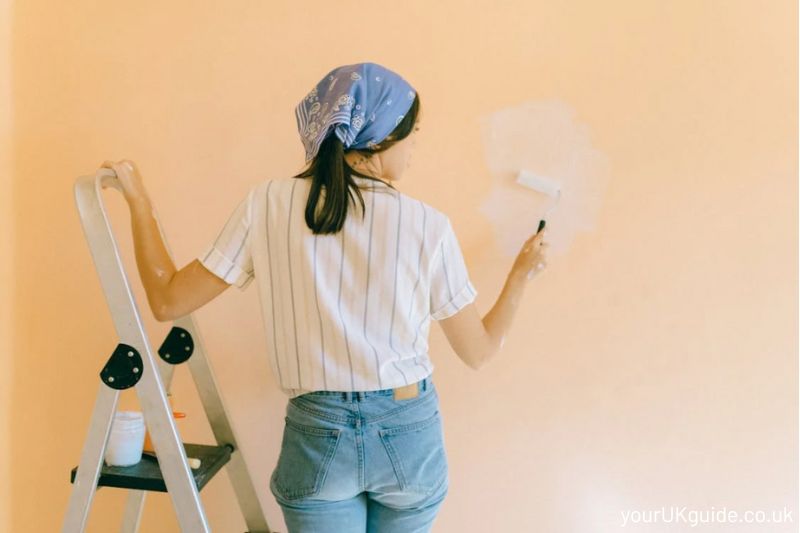There is something undeniably satisfying about doing work with your own two hands. The smell of fresh paint, the hum of a drill, the rhythm of sanding, home improvement can feel like a ritual. For many homeowners, renovation is more than an aesthetic upgrade. It is a way to create a space that reflects identity, effort, and intention.
But as empowering as it is, the do-it-yourself route has its limits. Some projects are perfect for a rainy weekend and a trip to the hardware store. Others demand far more knowledge, experience, and accountability than most of us have. Mistakes in the latter can become dangerous, expensive, or both.
So how do you know which is which? Let’s unpack.
Projects That Are Made for DIY
Painting Walls
Painting is often the first stop on the home improvement journey. It is approachable, relatively affordable, and deeply transformative. With the right prep work and attention to detail, anyone can breathe new life into a room with a few coats of paint.
However, ceilings are a different story. If your ceiling is textured or has water stains, this “simple” project can spiral into something far more complicated. Always evaluate the surface carefully before assuming the job will be easy.
Replacing Fixtures and Hardware
Upgrading cabinet handles or changing out a dated bathroom faucet can offer high visual impact with minimal risk. These are great beginner projects that require basic tools and a bit of patience.
Before starting any plumbing task, even a minor one, always shut off the water supply. It is one of those foundational habits that prevents a flooded under-sink surprise.
Peel-and-Stick Surfaces
Modern peel-and-stick materials have raised the bar for DIY. Whether it is a temporary backsplash in the kitchen or a bold wallpaper accent, the newest designs are made for commitment-phobes with good taste.
These products are forgiving. If you make a mistake, just peel it back and try again. There is no grout to mess with and no adhesive to clean up.
Floating Floors
If you are dreaming of replacing your floors, some materials are more beginner-friendly than others. Vinyl planks with a click-lock mechanism can often be installed without glue or nails.
But not all flooring is equal. Ceramic tile, real hardwood, and glued laminate require a completely different level of expertise. One bad cut or misalignment can ruin the whole project—and your patience along with it.
Projects That Walk the Line
Mounting Shelves or Wall Fixtures
On the surface, installing a floating shelf seems like a job anyone can handle. In reality, it depends entirely on what lies behind your wall.
Mounting into drywall without finding studs can end in tears and broken decor. Invest in a quality stud finder and know the weight limits of your fasteners. Improper anchoring is one of the leading causes of DIY regret.
Small-Scale Tiling
Installing a small tiled backsplash in your kitchen can seem manageable, especially with the endless video tutorials online. And sometimes it is.
But tiling is an art. Uneven lines, poor grout application, or skipped surface prep can make even a small area look unprofessional. If this is your first attempt, practice in a low-visibility area or consider an alternative surface treatment first.

Via Pexels
Absolutely Not: Projects That Require a Professional
Electrical Work Beyond Simple Fixture Changes
Changing out a light fixture or updating a dimmer switch is often safe enough for a capable homeowner. But anything that involves new wiring, breaker boxes, or circuits is a no-go.
Electrical systems are highly regulated for good reason. Improper installations can lead to fires, electrocution, and costly damage. No savings are worth the risk.
Structural Modifications
Removing a wall can open up a space dramatically. But if that wall is load-bearing, removing it without proper reinforcement can jeopardize your entire home’s stability.
Even experienced contractors consult structural engineers for this kind of work if you are tempted to swing a sledgehammer to “see what happens,” pause and get a professional evaluation first.
Plumbing That Alters the Layout
Replacing a shower head is one thing. Moving the location of a toilet or sink is another matter entirely.
Plumbing systems involve pressure, slope, ventilation, and strict building codes. If you are rerouting pipes or doing anything underground, you are not saving money—you are playing roulette.
Any Work Involving Gas
Whether you are relocating a stove, installing a new gas fireplace, or replacing a water heater, this is one area where you should never go it alone. Gas leaks are not just dangerous; they are potentially fatal. Professionals use pressure tests and specialized tools to ensure safety and compliance with local codes. Even if a gas project looks deceptively simple, leave it to a licensed technician. Your home and your health are not worth the gamble.
Know Your Tools—And Respect Their Complexity
One of the easiest ways to gauge whether a project is truly DIY-friendly is by looking at the tools it requires. If the list includes equipment you have never used—or even heard of—it may be a sign to slow down. Many renovation tasks call for specialized tools that demand a certain level of familiarity. For instance, tools like a wet tile saw, a brad nailer, or an oscillating tool can be incredibly efficient in the right hands but also surprisingly easy to misuse. Precision tools are not just about pressing a button; they rely on skill, experience, and a good understanding of the materials you are working with. Without that, even a straightforward job can go sideways fast. Before starting any new project, make sure you know not just what tools are needed, but how to use them safely and effectively.
The Hidden Cost of Saving a Few Bucks
DIY is often pitched as a cost-saving strategy. And in many cases, it is. But not always.
Factor in the cost of tools, materials, permits, wasted supplies from mistakes, and the time spent troubleshooting. Also consider the cost of fixing errors, or paying someone to fix what you tried to do yourself.
Bad DIY work can also hurt resale value. Crooked tiles, warped flooring, or visible patch jobs signal to buyers that the home may not have been well-maintained. Sometimes, paying a professional is not just the safer choice; it is the more economical one, too.
Ask Yourself Before You Begin
Before committing to a project, run through a quick checklist:
- Have you done this type of work before?
- Do you fully understand the steps and risks?
- Is the worst-case scenario manageable?
- Does the project involve structural, electrical, gas, or plumbing systems?
- Will you need a permit?
If any of your answers leave you uncertain, that is a signal to pause. Research more or hire someone who has the expertise.
Final Thoughts: Know Your Strengths
There is pride in doing things yourself. There is also wisdom in knowing your limits.
Celebrate the upgrades you complete with confidence. Painting a room, installing new hardware, or creating a gallery wall are beautiful, satisfying wins. But when it comes to areas where lives, safety, or serious money are on the line, humility is your best tool.
Your home is not a testing ground for guesswork. It is a place of comfort, safety, and investment.










